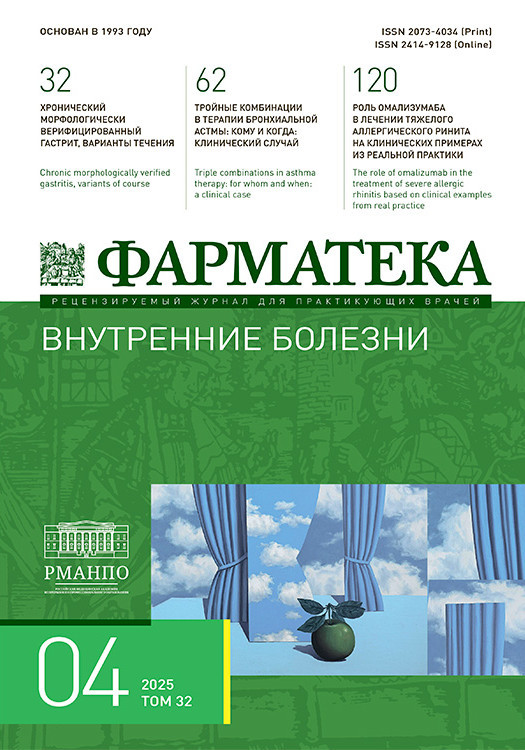Features of the course and effectiveness of treatment of right ventricular myocardial infarction combined with inferior left ventricular myocardial infarction
Background: Right ventricular (RV) myocardial infarction rarely occurs in isolation (2–3% of cases), more often (30–50%) it is combined with inferior left ventricular infarction. RV lesion is important to diagnose, since it changes the clinical picture. Usually, right coronary artery (RCA) occlusion causes infarction of both ventricles, leading to hemodynamic disturbances, including a decrease in the RV ejection fraction and a decrease in the volume of blood entering the left ventricle. Signs of right ventricular failure (swelling of the jugular veins, liver enlargement, edema) in inferior myocardial infarction should suggest possible RV involvement, although these signs may be mild or absent. Objective: Evaluation of the course of right ventricular myocardial infarction in combination with inferior left ventricular myocardial infarction and assessment of the effectiveness of the therapy. Materials and methods: The study included 67 patients with primary myocardial infarction of the inferior wall of the left ventricle (LV), including cases with right ventricular (RV) involvement. Inclusion criteria: chest pain >30 minutes, ST elevation ≥0.2 mV in the inferior ECG leads, and in case of RV involvement – ST elevation ≥0.1 mV in V3R–V4R leads. EchoCG assessed the following parameters: LV size and volume (EDR, ESR, EDV, ESV), ejection fraction (EF), left atrial (LA) size. RV function (TAPSE). Doppler analysis: transmitral and tricuspid flows (E, A, E/A, DT, IVRT and IVCT). All patients in this study were divided into two groups: the first group included 40 patients with isolated inferior LVMI, and the second group included 27 patients with inferior LVMI + RVMI. Inclusion criteria: acute inferior LVMI with/without RV involvement. Exclusion criteria: bundle branch block, heart defects, cardiogenic shock, etc. Statistical analysis: used: Microsoft Excel 2016 and SPSS 25 programs were used. Statistical significance was considered at p<0.05. Results: The study included 67 patients (43 (64%) men, 24 (36%) women), the age of patients: 45–55 years (20 patients) and 56–80 years (47 patients). All had type 2 diabetes mellitus, 45 patients suffered from arterial hypertension and 56 patients had dyslipidemia. As a result of echocardiography and Dopplerography: mean LVEF was 49.1±0.01 and 45.4±1.4; p=0.02; LV EDV – 158.1±2.7 and 170.4±1.2; p=0.02; LV ESV – 80.1±1.1 and 92.4±1.3; p=0.001. Signs of diastolic dysfunction of the LV and RV: mean E/A LV was 0.84±0.07 and 0.81±0.03; p=0.04, and E/A RV – 1.25±1.03 and 0.83±0.05; p=0.03; IVRT LV – 113.2±2.8 and 114.3±1.3; p=0.04; and on the contrary, IVRT RV 52.1±3.05 and 66.2±2.5 and p=0.01; DT LV – 213.4±7.3 and 214.4±9.3; p=0.6; on the contrary, mean E/A RV – 1.25±1.03 and 0.83±0.05; p=0.03. Right ventricle: RV systolic dysfunction (reduced TAPSE and RVs). Mean TAPSE was 18.6±1.6 and 16.2±0.15; p=0.012, and RVs – 10.8±0.25 and 8.1±1.4; p=0.04; only in patients with inferior MI and RV involvement. Some patients had atypical symptoms (epigastric pain, jugular vein distension). Statistically significant differences in SBP, LV EDV, LV ESV, LV EF, TAPSE, RVs and diastolic function parameters. The most pronounced LV and RV dysfunctions were found in patients with inferior MI and RV involvement, which emphasizes the importance of assessing right ventricular function in this pathology. Conclusion: The combination of right and inferior left ventricular infarction is a critical condition. Key success factors: early diagnosis and effective reperfusion of the right coronary artery. This will improve the prognosis and reduce mortality.Kh.D. Kalinle, O.V. Remizov, Z.T. Astakhova
Keywords
myocardial infarction
left ventricle
right ventricle
coronary artery
electrocardiography
echocardiography
systolic dysfunction
diastolic dysfunction
About the Authors
Hassan D. Kalinle, Postgraduate Student, Department of Internal Medicine No. 4, North Ossetian State Medical Academy, Vladikavkaz, Russia;hassanovozel@gmail.com, ORCID: https://orcid.org/0009-0000-8186-633X (corresponding author)
Oleg V. Remizov, Dr. Sci. (Med.), Rector, North Ossetian State Medical Academy, Vladikavkaz, Russia; ORCID: https://orcid.org/0009-0009-6313-7032
Zamira T. Astakhova, Dr. Sci. (Med.), Professor, Head of the Department of Internal Medicine No. 4, North Ossetian State Medical Academy, Vladikavkaz, Russia; ORCID: https://orcid.org/0009-0002-4855-1111



